The Virgin and Child with Saints Dominic and Aurea – Duccio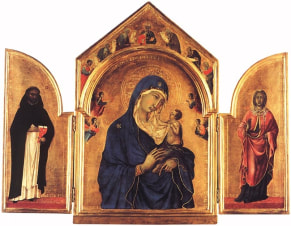 Duccio di Buoninsegna (d.1319), the Tuscan painter, chose to use real gold to represent stars and heaven in the altarpiece The Virgin and Child with Saints Dominic and Aurea. This portable altarpiece may have been commissioned by Cardinal Niccolò da Prato (d.1321), who was both a Dominican Friar and the Cardinal of Ostia. This would explain the saints on the wings of the triptych: Saint Dominic and Saint Aurea of Ostia. In the tympanum above the central panel are seven figures who have been identified as Old Testament prophets: Daniel, Moses, Isaiah, David, Abraham, Jacob and Jeremiah. They stand above a portrait of the Virgin Mary and the child Jesus, which is where Duccio has placed two stars; one on Mary’s shoulder and the other on the hood of her shawl. Duccio mixed gold leaf into his paint to draw these stars on top of the rich, blue egg tempera. The background of the entire wooden altarpiece was also painted in gold to represent the importance of heaven. The Adoration of the Kings – Gossaert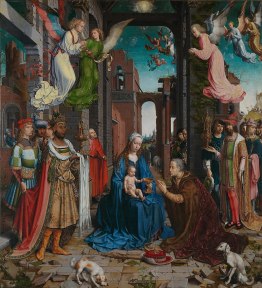 Of all the different genres of paintings, the one where you are guaranteed to find stars or at least a star are scenes of the Nativity. According to the Gospel of Matthew, wise men or magi followed a star from the East, which led them to a humble stable in Bethlehem. Paintings of this nature are often called The Adoration of the Kings or The Adoration of the Magi. Jan Gossaert (1478-1532) was one of many artists to depict this biblical scene. Mary, dressed in blue, sits with the Christ-child in the ruins of a building, receiving a gift from one of the “kings”. The Bible never mentioned the visitors were kings and nor did they have names. Art historians, however, have given this figure the traditional name Caspar. Melchior stands to the right of Caspar and Balthazar to the left. Alongside the “kings” are several exotically dressed attendants and more can be seen approaching in the distance. 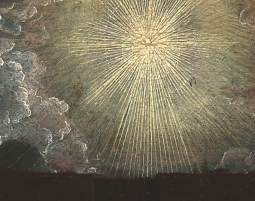 Floating above the scene are angels and right at the top, slightly dwarfed by everything else in the painting, is the Star of Bethlehem. The entire composition was painted on oak panels that when pieced together measured 177.2 cm (69.8 in) by 161.8 cm (63.7 in), and the star does not take up much space at all. Nonetheless, when studied closely, Gossaert’s precise brushstrokes and painstaking detail emphasise the importance of this star. Most likely painted in lead-tin-yellow, the star lights up the sky around it, appearing to push the surrounding clouds away so that it can shine over the Christ-child. The Adoration of the Kings – Carlo Dolci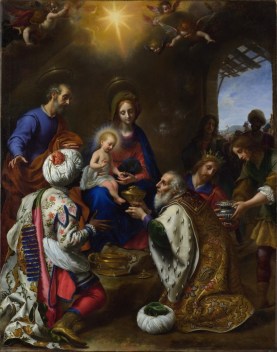 The star is much more prominent in the Baroque painter, Carlo Dolci’s (1616-86) version of the subject. This highly finished picture contains fewer people than Gossaert included, keeping the focus on the three “kings” in opulent robes as they kneel before Mary and the Christ-child. Although their gifts look important and expensive, they are executed in paint, whereas the haloes over Mary and Joseph and the light surrounding Jesus’ head was painted in gold. Although the figures and their robes were painted in rich colours, the Star of Bethlehem outshines them all. The star’s light bursts forth from the clouds above, making it the brightest part of the painting. When looking at the composition as a whole, the eye is constantly drawn upwards to the star, which some see as a symbol of God looking down on his precious son. The Adoration of the Kings – Filippino Lippi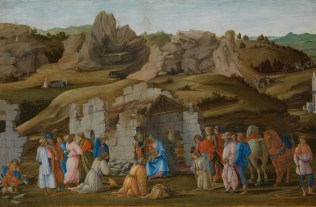 In contrast to the previous two paintings, Filippino Lippi’s (1457-1504) version contains a less obvious star, fading in the light of the daytime sky. Probably due to the star mentioned in Matthew’s Gospel, artists tended to portray the visit of the magi at night rather than during the day. Another difference between Lippi’s version and the traditional version is the landscape. The Holy Family sit in the ruins of a building in a rocky landscape. They have very little shelter and there appear to be no other establishments nearby. As well as the “kings” and their retinue, there are several saints hidden in the background. These have been identified as Mary Magdalene, Bernard of Clairvaux, Jerome and Augustine. There is also a representation of the Archangel Raphael and Tobias. 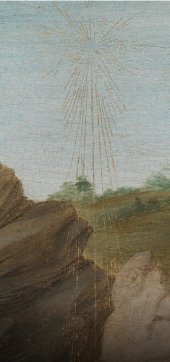 The way Lippi chose to portray the star is very different from the previous two examples. To begin with, it appears much lower in the sky, floating above the Holy Family. Rather than a solid or compact star, it resembles a firework. Lines of golden light appear to be shooting in all directions, some landing within touching distance of the figures below. Yet, this slightly faded star does not make it seem less important than other versions. The explosion of light beams emphasises God’s magnificent power that, although it is not easy to see in the daylight, is always there. Lippi’s painting was the last to feature in the National Gallery’s Star Trail. The handful of paintings they looked at revealed that stars have been important in science, mythology and religion. Of course, there are so many more examples of stars in the National Gallery and other locations. Each artwork demonstrates one method of representing stars. Some artists opt for a five-pointed star, whereas others choose a greater number. Alternatively, a star can be represented by a ball of light or the smallest of dots, as Turner chose. To read the full article, click here This blog post was published with the permission of the author, Hazel Stainer. www.hazelstainer.wordpress.com
0 Comments
Your comment will be posted after it is approved.
Leave a Reply. |
©Copyright
We are happy for you to use any material found here, however, please acknowledge the source: www.gantshillurc.co.uk AuthorRev'd Martin Wheadon Archives
June 2024
Categories
All
|
 RSS Feed
RSS Feed